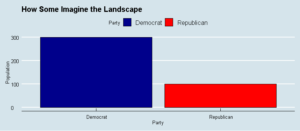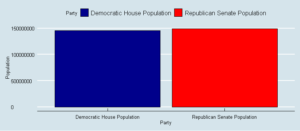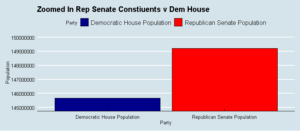Impeachment? Actually The Majority Would Rule (R )
Among Democrats these days there is much talk of impeaching Donald Trump but the conversation always comes around to someone saying “Even if the Democratic controlled House did vote for impeachment the Republican Controlled Senate would vote against it.” Behind this is the understanding that densely populated areas are Democratic while sparsely populated areas are Republican. The sentiment is that states with big populations like New York ( pop 19 million) and California (pop 39 million) are having their wills thwarted by states with meager populations like Wyoming (pop 577,000) and North Dakota (pop 760,000) which have the same number of Senators as their more populous rivals. But this is not so. It turns out that the population of Democratic House seats constituents is actually less than the number of Republican Senate seats constituents.
This is how Democrats who feel they are being thwarted imagine things

But actually here is the way things are.

And if we zoom in ? Now who has the right to feel aggrieved?

How did we arrive at this?
Here is the list of states and their populations: https://docs.google.com/spreadsheets/d/e/2PACX-1vStOCqQZIebV3e4LApdnMkrvmLyYPbg4eou4WJS-Y7p_490A-Dd90sIgKiETp-wjybghyKXj-uvfh78/pubhtml
And here is the list of Senate and House Representatives. Note we corrected Alabama’s Jeff Session(Republican) to Doug Jones (Democrat):
https://docs.google.com/spreadsheets/d/e/2PACX-1vTAedl2DEBOJeetdn_wPuYr2yYamrXEMJtef1_PgChLp0Dg4oBVlrI2IKm3a5X9Wqbe1SqN88F95Cvk/pubhtml
We will subset the Republican senate seats from all senate seats and join this against a list of all states and their populations. By tallying up the subset of those state’s populations we will find out approximately how many constituents Republican senators represent and compare this with the number of Democrat House constituents.
Using R:
First let us separate out Senators from Representatives
Senators<-Representative%>%
filter(Chamber==”Senator”)
Next we will filter out the Republican Senators
Senators_Republican<- Senators %>%
filter(Party == “Republican”)
To find the number of Republican Senators we group by state and tally party
Senators_Republican<- Senators_Republican %>%
group_by(State_Label)%>%
add_count()
Now select only states where BOTH Senators are Republican
Both_Republican<- filter(Senators_Republican,n>1)
write.csv(Both_Republican,”Both_Republican.csv”)
Now get get list of states with no redundancies
Republican_States<- distinct(Both_Republican, State_Label)
Next we will reduce the list of all states and their populations
to only those that where both senators are Republican.
Two_Rep_states_Pop<- semi_join(State_Populations,Republican_States, by = “State_Label”)
Now let us sum the populations of states that have two Republican senators
sum(Two_Rep_states_Pop$Population) # They sum to 107700049
Next we will get the list of states with only 1 Rep senator
One_Republican<- filter(Senators_Republican,n<2)
Now let us sum up those state’s populations
Single_Republican_Population <-sum(One_Rep_states_Pop$Population)
Single_Republican_Population
States with only one Republican Senator sum to 83012170
We will assume they represent only half of their constituent’s views so we will divide the state’s population in half.
83012170 /2 = 41506085
TOTAL Population represented by Republican Senators = 149206134
107700049 + 41506085
Next We will Get The Population Of The Congressional Districts Represented By Democrats
First let us separate out Senators from Representatives this time keeping the Representatives
House<-Representative%>%
filter(Chamber==”Representative”)
Next we will filter out Republican Representatives
Dem_House<- House %>%
filter(Party == “Democratic”)
Since each House Seat represents the same number of constituents we do not need to sum the state populations but merely multiply the number of Dem House seats by 747,000.
So how many House seats are controlled by Democrats? 195
dim(Dem_House) 195
Democratically controlled House Seats x 747,000 constituents per electoral district.
195*747000
#Democratic Houses Constituents sum to 145,665,000
Recent Comments